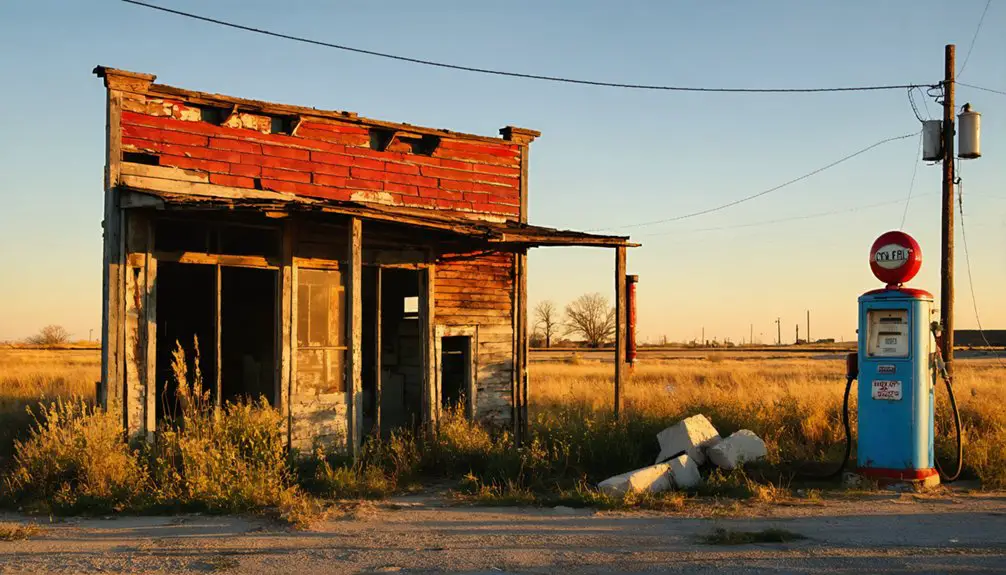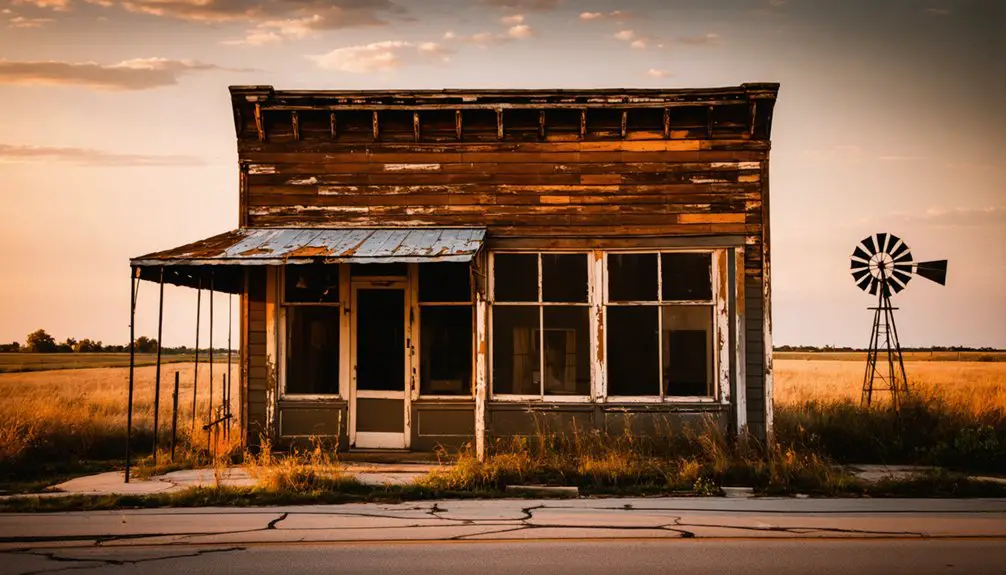You’ll find Alhambra in Oklahoma’s ghost town history as a late 19th-century settlement that flourished along the Oklahoma Central Railroad. The town grew rapidly after 1893’s Cherokee land division, establishing churches, schools, and a bustling commercial district with banks and general stores. While the Great Depression, Dust Bowl, and changing transportation routes led to its decline, Alhambra’s abandoned structures and landmarks still tell compelling stories of Oklahoma’s territorial expansion.
Key Takeaways
- Alhambra thrived as a railroad settlement in early Oklahoma, with commerce centered around the Oklahoma Central Railroad’s construction in 1906.
- The town featured essential businesses including general stores, banks, and grain elevators during its peak in the early 1900s.
- Economic decline began during the Great Depression, coupled with agricultural devastation from the Dust Bowl era.
- Railroad abandonment and highway bypasses severely isolated the community, leading to significant population loss.
- Today, abandoned structures including houses, churches, and commercial buildings remain as testament to Alhambra’s past.
Early Settlement and Town Origins
While Oklahoma’s territorial expansion in the late 19th century sparked numerous settlements, Alhambra emerged as one of many frontier towns shaped by the era’s land runs and territorial openings.
Many early pioneers established liquor towns and boomtowns during this period of growth and development.
You’ll find that settlement patterns in this region reflected the broader transformation of Native American lands through allotments and redistributions. The town’s establishment likely followed economic influences common to Oklahoma settlements, with early residents drawn by agricultural prospects and potential resource discoveries. The presence of oil discoveries in nearby regions contributed to settlement hopes and economic dreams.
Like many frontier communities, Alhambra’s founders would’ve prioritized basic infrastructure needs, establishing essential services such as general stores and possibly a post office.
Frontier settlements like Alhambra focused on essential infrastructure first, ensuring residents had access to basic goods and postal services.
The town’s success hinged on critical factors including market access for agricultural goods and proximity to transportation routes, which determined the flow of trade and new settlers.
The Rise of Alhambra’s Community
During Alhambra’s peak years, you’d find a bustling community centered around the railroad, which facilitated crucial trade connections to surrounding regions.
The town’s commercial district grew to include essential businesses like general stores and blacksmith shops, serving both local residents and travelers passing through. In 1893, Oklahoma saw mass land parceling as Cherokee territory was divided into 42,000 pieces for settler claims. Like many Oklahoma communities, Alhambra’s fate was ultimately shaped by railroad routing decisions.
Churches and schools emerged as social gathering places, helping to forge strong community bonds among the area’s farming and ranching families.
Early Railroad Settlement Days
As the Oklahoma Central Railroad began construction in 1906, connecting Lehigh to Chickasha, a series of strategic settlements emerged along its 127-mile route.
You’d find railroad influence shaping settlement patterns as towns sprouted up near the tracks, driven by the promise of coal transport and agricultural shipping opportunities. Like many other Oklahoma towns, grain elevators became essential infrastructure, reminiscent of communities such as Carmen that flourished as major wheat-shipping centers.
- Railroad companies actively designed and sold townsites, establishing essential infrastructure
- Mixed trains carried both passengers and freight, connecting rural residents to markets
- Companion businesses like grain elevators and coal yards quickly appeared trackside
- Post offices and commercial buildings followed the rail line’s path through Oklahoma
The railroad’s presence transformed the landscape, as you’d see coal mining operations and farming communities flourishing along the tracks. Communities benefited from the Amsterdam Stock Exchange financing that helped establish the railway infrastructure.
This rail connection wasn’t just about transport – it was your lifeline to economic opportunity and regional mobility in early 1900s Oklahoma.
Commerce and Trade Growth
The arrival of the railroad sparked Alhambra’s rapid transformation into a bustling commercial hub in the early 1900s. Mining influences shaped the town’s development as lead and zinc operations attracted diverse workers, merchants, and service providers, establishing essential trade networks throughout the region.
You’d have found multiple banks supporting local businesses by the late 1910s, while retailers, theaters, and hotels flourished to serve the growing population. The Commerce Mining and Royalty company played a significant role in developing the area’s economic foundation.
The Oklahoma, Kansas and Missouri Inter-Urban Railway, along with nearby highways, connected Alhambra to larger markets, enabling efficient movement of mining products and supplies.
The town’s commercial character was further shaped by the pre-1907 liquor trade, with saloons and dance halls contributing to a vibrant local economy. Similar to the infamous No Man’s Land of Beer City, these establishments operated with minimal legal oversight.
Like many mining communities, Alhambra’s commerce remained closely tied to the boom-and-bust cycles of mineral extraction.
Social Gathering Hubs Emerge
With the influx of settlers in early Alhambra, social gathering hubs quickly emerged to unite the growing population. You’d find communal spaces forming organically around key locations that served multiple purposes in daily life.
The town’s social fabric was woven through these essential community centers:
- General stores doubled as meeting spots where you’d catch up on local news.
- Churches hosted both religious services and social events year-round.
- Schools transformed into venues for public gatherings after class hours.
- Post offices became communication hubs where residents exchanged stories.
These gathering places strengthened community bonds and fostered a shared identity.
Near transportation routes like railroads and trails, social activity flourished as goods and visitors brought fresh energy to town events, creating a vibrant atmosphere that defined Alhambra’s peak years. Like many Oklahoma communities, the arrival of the railroad in 1926 sparked significant growth in local businesses and social interactions. Similar to Burlington’s experience, the school consolidation helped maintain a stable population and kept the community connected.
Peak Years and Economic Activity
Located in Oklahoma Territory during the late 19th and early 20th centuries, Alhambra reached its peak as a small agricultural community supporting local farming and ranching families.
You’d have found a bustling town economy driven by local trade and agriculture, with merchants serving the needs of area producers. Like many frontier settlements, Alhambra likely benefited from the region’s liquor trade before Oklahoma statehood in 1907 brought prohibition laws.
Though no specific population figures exist, the town’s economic activity would’ve depended heavily on its proximity to transportation routes and nearby market centers.
The agricultural economy sustained the community through its peak years, with farmers and ranchers regularly conducting business in town while seasonal workers passed through seeking employment opportunities.
Daily Life in Historical Alhambra

Life in historical Alhambra centered around modest wooden homes clustered near the town’s core, where you’d find residents going about their daily routines in frontier-style buildings adapted to Oklahoma’s climate.
Community interactions shaped the rhythm of daily life, with activities revolving around farming cycles and social gatherings.
Small-town rhythms flowed through seasonal plantings and harvest festivals, weaving neighbors together in life’s daily dance.
Your typical day in Alhambra would include:
- Morning farm work or trade duties, from tending livestock to operating local shops
- Children attending the one-room schoolhouse while helping with family chores
- Women managing household tasks, including food preservation and crafts
- Evening social activities at churches, schools, or community events
The town’s walkable layout meant you’d regularly cross paths with neighbors at the general store, post office, or during seasonal celebrations, fostering a tight-knit community despite the frontier’s challenges.
Factors Leading to Decline
You’ll find Alhambra’s decline closely tied to the vanishing economic opportunities that once sustained the town’s growth and significance.
The shift in transportation routes, particularly changes in railroad lines and highway development, dealt a severe blow to the town’s commercial prospects.
As businesses lost their customer base and transportation access became limited, the town’s population began to dwindle, marking the beginning of its transformation into a ghost town.
Economic Opportunities Vanish
While Alhambra initially thrived as an agricultural community, multiple economic factors converged in the early to mid-1900s to strip away its economic opportunities.
You’ll find that Alhambra’s economic decline accelerated through a devastating chain of events that left few options for its residents:
- Agricultural shifts during the Dust Bowl devastated local farmland, driving out farmers and their families who could no longer sustain their livelihoods.
- The Great Depression struck a severe blow to local businesses and banks, drastically reducing available capital and consumer spending power.
- Mechanization of farming operations eliminated many manual labor jobs, forcing workers to seek employment elsewhere.
- Young residents began moving to urban areas for better opportunities, leading to an aging population and further shrinking the town’s economic base.
Transportation Routes Change
As transportation networks evolved across Oklahoma in the mid-1900s, Alhambra suffered devastating blows to its connectivity and economic significance.
You’d have witnessed major transportation changes as railroads abandoned their routes through town. The Southern Pacific Railroad discontinued its lines to Duarte and Pasadena, while Union Pacific’s takeover led to reduced passenger service.
The town’s once-strategic location became a liability when new highways bypassed the area entirely.
The route abandonment didn’t stop there. When regional infrastructure projects like reservoirs and dams required rerouting existing networks, Alhambra found itself increasingly isolated.
Without diverse transportation options, the town couldn’t compete with nearby communities that maintained better highway and rail access.
The shift from rail to automobile transit sealed Alhambra’s fate, leaving it disconnected from essential economic centers.
Remaining Structures and Landmarks

Today’s visitors to Alhambra will find several remnants of this once-bustling Oklahoma town. Abandoned structures and historical landmarks tell the story of a community that time has slowly reclaimed.
You’ll discover mid-20th century service stations with rusty signage, and weathered commercial buildings that line the former main streets.
- Original houses stand vacant with boarded windows and deteriorating roofs
- Historic churches and schoolhouses remain, some with visible chalkboards inside
- Old road beds and railway remnants trace transportation routes through town
- Nearby cemeteries stay relatively maintained despite the town’s abandonment
Native grasses and small trees now grow freely among concrete foundations and empty lots.
You’ll spot occasional boundary markers and rusted fencing, while former agricultural fields stretch beyond the town’s footprint, painting a picture of Alhambra’s past prosperity.
Notable Residents and Stories
Beyond the weathered structures and vacant buildings, the stories of Alhambra’s former residents paint a vivid picture of frontier life in early Oklahoma.
The town’s population consisted mainly of young men drawn to mining and railroad jobs, while families struggled to maintain stability through farming and ranching. Notable legends emerged from the town’s lawless period, when self-appointed lawmen and outlaws shaped the community’s character.
Rugged young miners and railroad workers defined early Alhambra, while outlaws and vigilante justice shaped its wild frontier spirit.
You’ll find community folklore centered around the saloons and informal gathering places where residents sought refuge from their harsh living conditions.
Like many settlements in “No Man’s Land,” Alhambra’s residents faced the challenges of isolation and economic uncertainty. Their stories, passed down through generations, reflect the boom-and-bust cycle that ultimately led to the town’s abandonment.
Historical Significance in Oklahoma

While many Oklahoma ghost towns faded into obscurity, Alhambra’s historical significance stems from its crucial role during the state’s formative years.
You’ll find its cultural heritage deeply intertwined with Native American history, particularly the Osage tribe, as the town served as a essential gathering place for tribal communities.
- Positioned strategically near major oil discoveries, Alhambra exemplified economic resilience during the early 20th-century boom.
- The town became a focal point of tribal wealth management and social transformation when oil revenues reshaped local communities.
- Its buildings and institutions functioned as important cultural centers, bridging Native American traditions with frontier settlement.
- Alhambra’s story mirrors Oklahoma’s complex narrative of resource exploitation, tribal relations, and boom-and-bust economics.
Visiting the Ghost Town Today
Adventurous travelers seeking to explore Alhambra’s ghost town ruins should prepare for a remote, minimalist experience.
You’ll need to navigate local country roads using GPS coordinates and old maps, as signage is minimal and cell service unreliable. For safe ghost town exploration, bring water, first aid supplies, and sturdy footwear.
The site consists mainly of scattered foundations and debris amid overgrown vegetation. You won’t find any intact buildings or visitor facilities, but you’re free to photograph the exterior remains while respecting private property boundaries.
Watch for unstable ground, wildlife, and weather exposure during your visit. Since emergency services are distant, it’s essential to plan your communication strategy and evacuation routes before arrival.
Consider researching the town’s history at nearby museums or county archives to enhance your experience.
Frequently Asked Questions
Were Any Movies or TV Shows Ever Filmed in Alhambra?
You won’t find any documented film locations or television series shot in this area. Available records and production databases don’t show any movies or TV shows ever filming there.
What Native American Tribes Originally Inhabited the Area Before Alhambra’s Establishment?
Over 500 years of tribal history reveal that Spiro Mound builders first inhabited the area, followed by Caddoan tribes like the Wichita, then Siouan peoples including Quapaw and Osage with cultural significance.
Did Any Major Crimes or Unsolved Mysteries Occur in Alhambra?
You won’t find any documented unsolved crimes or historical mysteries in this town’s records – research shows its decline was tied to economic factors rather than criminal or unexplained events.
Are There Any Documented Paranormal Activities or Ghost Stories From Alhambra?
You won’t find documented ghost sightings or haunted locations from Alhambra in historical records. While Oklahoma has many paranormal legends, none are specifically tied to this abandoned town.
What Natural Disasters Significantly Impacted Alhambra Throughout Its History?
While Oklahoma averages 52 tornadoes yearly, you won’t find specific records of tornado impact or flood history in Alhambra, though the town likely endured typical regional severe weather patterns.
References
- https://en.wikipedia.org/wiki/List_of_ghost_towns_in_Oklahoma
- https://www.okhistory.org/publications/enc/entry?entry=GH002
- https://www.youtube.com/watch?v=zTKa5i1czdE
- https://www.youtube.com/watch?v=ifra0DI–dY
- https://kids.kiddle.co/List_of_ghost_towns_in_Oklahoma
- https://okmag.com/blog/a-ghostly-site/
- https://www.kosu.org/local-news/2014-05-23/ghost-towns-all-black-oklahoma-towns
- https://freepages.rootsweb.com/~gtusa/history/usa/ok.htm
- https://www.youtube.com/watch?v=jcbyntLCj2U
- https://advocate.jbu.edu/2020/11/12/oklahomas-environmentally-toxic-ghost-town



